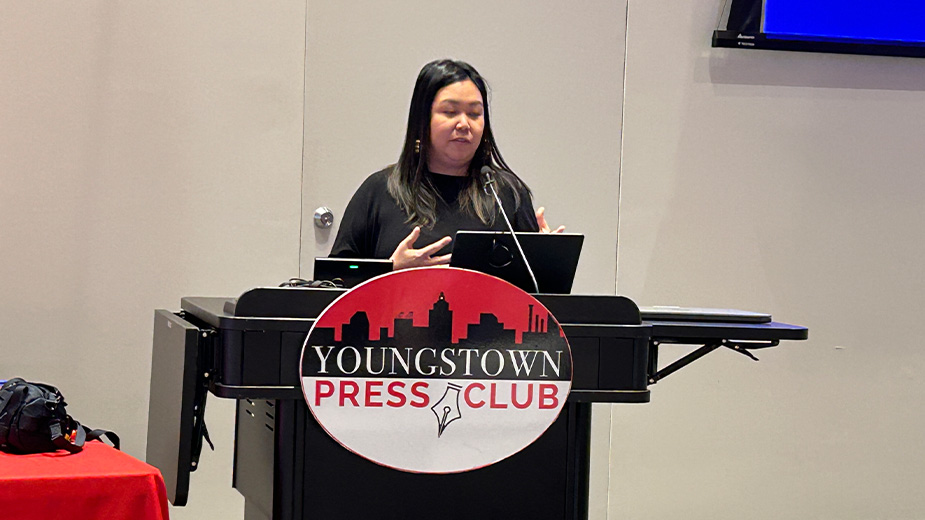Tariffs and Soggy Fields Dampen Farm Forecasts
YOUNGSTOWN, Ohio — It’s taken just more than a couple of years to dismantle what took farmers across Ohio decades to build – a thriving international market that ensured stable profits even in the worst of times.
The worst of times has arrived again. But this season, farmers in the region no longer have the cushion of the global marketplace to absorb some of these losses, as U.S. trade policy and other factors have wreaked havoc on growers everywhere.
Dairy producers, soybean farmers and corn growers are all feeling the pinch of the weather, retaliatory tariffs from China and uncertainties related to other trade agreements, especially those with Canada and Mexico, say area farmers and agricultural specialists. Moreover, inclement weather that has affected most of the Midwest this year has delayed planting for farmers that desperately rely on a timely harvest in the fall.
“Usually, by this time we’re a quarter of the way done,” says Lee Beers, extension educator for agriculture and natural resources at the Ohio State University Cooperative Extension in Trumbull County. “It’s been so wet that I’d estimate just 1% to 2% of the county is planted.”
That makes it a risky year for the corn crop, Beers says. “It is so saturated that you can’t get tractors on to the fields,” he says. “One of our largest farms in the county has just 5% planted for corn right now.”
On a brighter side, Beers says that should corn production drop because of foul weather, commodity prices should rise. “If a lot of farms don’t get planted, it could drive the price of corn up.”
There is another option. Farmers faced with similar situations in the past have converted their crop to soybeans, since the planting season for this crop falls later in the spring than corn. Thus, should the fields dry out later, they could still be salvaged with a solid soybean crop.
But not this year. Tariffs enacted by the Trump administration in 2018 on a variety of products imported to the United States from China resulted in retaliatory measures that included a 25% penalty on soybeans imported from the United States. As such, soybean farmers are struggling to navigate a market that is bereft of a once lucrative customer in China.
“We don’t have much of anything planted yet,” says Harvey Lutz, owner of Lutz Farms in Lordstown, which grows mostly corn and soybeans. “For anybody in the grain world right now, exports are soft and we’re choking on inventory. Delays in planting bring our yields down.”
Lutz farms about 2,200 acres along Leavitt Road. The crop is usually divided between corn and soybeans, most of which are used as animal feed. A small percentage of the crop is devoted to growing sweet corn for consumers.
“The tariffs placed the kibosh on us,” Lutz says, referencing his soybean crop. Soybeans are generally converted into two products: oil used mostly in cooking and meal that is used for protein in livestock feed.
He then sends a significant amount of his crop to Schwartz Farms in Trumbull County, which prepares the beans for shipment to grain elevators. From there, the soybeans are sold all over the country and world. “They go everywhere,” Lutz says.
Approximately one-third of the soybean crop in the United States was exported to China before the tariffs hit, says Kirk Merritt, executive director of the Ohio Soybean Association.
“Soybeans are the No. 1 agricultural revenue source in Ohio,” Merritt says. In 2018, direct revenue from soybean farming amounted to $2.5 billion across the state and Merritt estimates the crop has a $5 billion economic overall impact on the Ohio economy. “It’s a significant part of the agricultural economy,” he says.
According to the Soybean Council, soybean farms in Trumbull County contributed $11.2 million to the local economy in 2017. Meanwhile, soy farmers in Columbiana County saw a more than a $10 million economic impact, while Mahoning County reported $6.3 million in revenue from the crop.
This year, the Chinese market is essentially shut off to Ohio soybean farmers, Merritt says; exports of the product are down 80%. If there is a silver lining, it’s that closing off the pipeline to China has stepped up efforts among Ohio soybean farmers to pursue new customers in Europe, Mexico and the Middle East.
“Exports to Europe are up 124%; exports to Mexico are up 37%,” he says. Other global markets that look promising are Taiwan, Egypt and Pakistan, he adds.
Still, improvements in these markets combined don’t come close to offsetting the loss of business in China, Merritt says. Even with market share gains in other parts of the world, net exports of soybeans have dropped 30%. “Before the trade war, we exported 60% of our crop,” he says. “When it drops by 30%, that’s a big deal.”
Moreover, it took decades for soy farmers to cultivate these trade relationships. A major concern is that China has started to source most of its soybeans from Brazil. A prolonged trade war would only strengthen trade connections between those two countries, potentially leaving the United States out of the market when these trade issues are settled.
“I don’t think we can assume that lifting the tariffs will make China come back magically like before,” Merritt says. “We’re going to have to work for that.”
Soybean growers across the country first started discussing trade with China during the early 1980s, and it took a long time to realize the benefits, Merritt says. “There were many years that we didn’t sell a bushel to China,” he says. “It might not come back to the same level as before, but we think it can still be a great market.”
On May 23, the U.S. Department of Agriculture announced it would allocate $16 billion in new subsidies to support farmers hurt by China’s retaliatory tariffs. The aid package would make $14.5 billion in direct payments to producers, including soybean growers, through the Commodity Credit Corp. Payments would be made in three tranches, the first of which begin in late July and early August. Should conditions warrant, the second and third tranches would be made in November and early January 2020, according to USDA.
The federal government would use another $1.4 billion to purchase surplus commodities affected by the trade war such as fruits, vegetables, beef, pork and lamb. These commodities would then be distributed to food banks, schools and outlets that serve low-income individuals. Another $100 million would be used toward developing new markets for farmers.
Last year, the Trump administration provided $12 billion in emergency funds to farmers.
While the subsidies to soybean farmers have helped, they are an inadequate remedy in the face of broader, more damaging problems ahead for soybean farmers, Merritt says.
The Ohio dairy industry is also feeling the pinch of uncertain international trade agreements, says Dianne Shoemaker, field specialist in dairy production and economics with the Ohio State University Extension in Mahoning County.
“Our industry is all tied to global markets,” Shoemaker says. Under the former North American Free Trade Agreement, or Nafta, dairy farmers enjoyed a strong market with Mexico – not so much Canada, she notes. “Mexico buys a lot of dairy products,” she says. “Nafta helped to develop good stable markets for dairy.”
It’s unclear how dairy products will be affected by the new trade agreement advanced by the Trump administration – the U.S.-Mexico-Canada Agreement, Shoemaker says. “All of this adds to uncertainty,” she says.
Shoemaker says the Chinese market has been stable for dairy farmers and the industry maintains a positive trade balance there. “China is a big importer of dry whey,” a byproduct of cheese production used as a stable protein source for piglets.
Tariffs have hampered this market as well, according to the U.S. Dairy Export Council. In January, whey shipments to China were the lowest they’ve been in seven years, in part because of China’s retaliatory tariffs.
Another reason for the shortfall, Shoemaker says, is a case of swine fever that has infected a large portion of the pig population in China.
Over the last four years, dairy prices have also plummeted in large part because the global market is saturated with an oversupply of both milk and cows, Shoemaker says. Although there’s some recent data suggesting a slight price increase, she’s skeptical as to whether it’s strong enough to sustain local farms.
“They’re showing some signs of strength,” Shoemaker remarks. “But, will they be high enough?”
Domestic competition has also taken its toll in northeastern Ohio. Local dairy prices, for example, have been under pressure since large farms in Michigan started to sell aggressively into the Buckeye State – especially in northeastern Ohio. Many dairy processors have found they could source milk more cheaply from Michigan farms than local producers, forcing many out of business.
“Ohio has lost a tremendous amount of dairy farms,” Shoemaker says. “Many dairy families have a second source of income, or they’ve left the business.”
During 2017 and 2018, the number of dairy farms exiting the business was three times higher than the previous 10 years, Shoemaker says. “That trend has continued.”
Pictured: Lutz Farms owner Harvey Lutz says rainy weather has delayed many farmers in planting their crops.
Copyright 2024 The Business Journal, Youngstown, Ohio.


